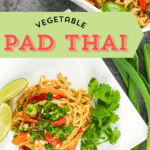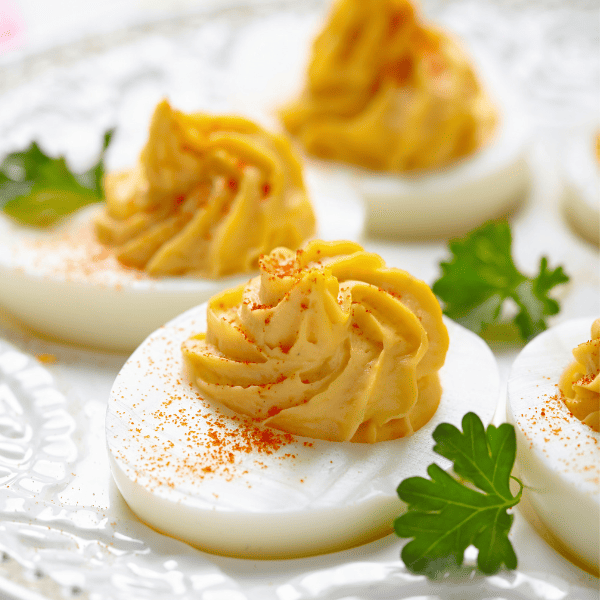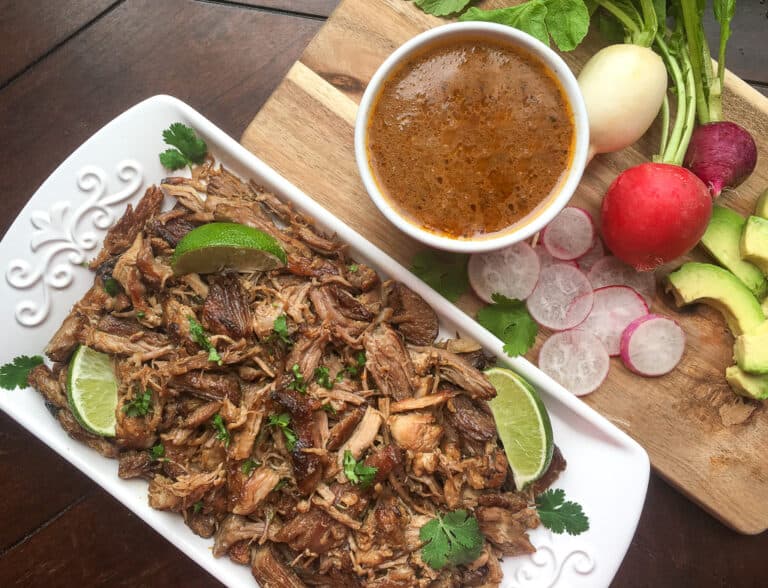Experience a delightful fusion of flavors and textures with our Vegetable Pad Thai recipe. This vibrant dish brings together tender rice noodles, crisp vegetables, and a luscious peanut sauce, creating a meal that’s both satisfying and nutritious. Whether you opt for white or brown rice noodles, you’ll find this recipe easy to prepare and perfect for any occasion.
Ready in just 30 minutes, this dish is a great choice for a quick and wholesome meal. Enjoy it with a squeeze of fresh lime and a sprinkle of crushed red pepper flakes for an extra kick!

What is Vegetable Pad Thai?
Vegetable Pad Thai is a tasty Thai noodle dish made with rice noodles, fresh vegetables, scrambled eggs, and a sweet and tangy peanut sauce. It’s known for its mix of sweet, salty, tangy, and spicy flavors, making it a favorite meal.
To make your meal even better, you can pair Vegetable Pad Thai with some simple side dishes and drinks. Try having it with crisp vegetable or shrimp spring rolls and a dipping sauce for a light and refreshing starter.
A Thai mango salad, with its mix of sweet, sour, and spicy flavors, goes great with the noodles. Steamed dumplings filled with vegetables or shrimp are also a tasty appetizer. Coconut rice, with its mild sweetness, balances the flavors of the Pad Thai and helps cool down any spiciness.
Vegetable Pad Thai Ingredients
With a prep time of just 15 minutes and a cook time of 15 minutes, you’ll have a delicious dish ready in half an hour. This recipe serves 4, making it ideal for a family dinner or a small gathering.
Pad Thai Ingredients:
- Rice Noodles – These noodles form the base of the dish and are cooked until tender.
- Sesame Oil – Adds a rich, nutty flavor to the stir-fry.
- Shallot – Provides a mild onion flavor.
- Green Onions – Add a fresh, sharp taste.
- Carrot – Brings a slight sweetness and crunch.
- Red Pepper – Adds color and a mild, sweet flavor.
- Eggs – Provide protein and a creamy texture.
- Roasted Peanuts – Add a crunchy texture and nutty flavor.
- Cilantro Leaves – Offer a fresh, citrusy note.
- Limes – Used for squeezing fresh juice over the dish for a tangy kick.
- Crushed Red Pepper Flakes – For those who enjoy a bit of heat.
Sauce Ingredients:
- Honey – Adds sweetness to balance the tangy and salty flavors.
- Fish Sauce – Provides a salty, umami depth to the sauce.
- Tamari or Coconut Aminos – These are soy sauce alternatives that add a savory flavor.
- Rice Vinegar – Brings a tangy acidity to the sauce.
- Fresh Lime Juice – Adds a bright, citrusy flavor.
- Sugar-Free Creamy Peanut Butter – Gives the sauce a rich, creamy texture.
- Garlic Chili Sauce – Adds a bit of spice and garlic flavor to the sauce.

How to make Vegetable Pad Thai?
Follow these simple steps to create a delicious dish that’s sure to impress, even if it’s your first time making it.
- Start by preparing the rice noodles according to the instructions on the package. After cooking, rinse them under cool water to prevent them from sticking together and set them aside.
- While the noodles are cooking, combine the sauce ingredients in a small skillet over medium-low heat: 1/3 cup honey, 3 tablespoons fish sauce, 2 tablespoons tamari or coconut aminos, 1 tablespoon rice vinegar, 2 tablespoons fresh lime juice, 2 tablespoons sugar-free creamy peanut butter, and 1 tablespoon garlic chili sauce. Stir continuously until the peanut butter melts and the sauce is well-mixed and heated through, about 3-4 minutes. Remove from heat and set aside.
- In a large non-stick skillet, heat 1 tablespoon of sesame oil over medium heat. Add the finely chopped shallot, the white parts of the sliced green onions, the matchstick-cut carrot, and the sliced red pepper. Cook, stirring frequently, until the vegetables are tender and slightly browned, about 4-5 minutes.
- Push the cooked vegetables to one side of the skillet. Pour the whisked eggs into the other side of the skillet. Stir and chop the eggs with a spatula as they cook, until they are fully cooked and in small pieces, about 4-5 minutes.
- Add the cooked rice noodles, 1/3 cup of the chopped roasted peanuts, and the warm sauce to the skillet with the vegetables and eggs. Stir everything together until well combined and heated through.
- Finally, divide the Pad Thai into individual serving dishes. Top each serving with the remaining chopped roasted peanuts, the green parts of the sliced green onions, and the chopped cilantro. Serve with lime wedges on the side for squeezing over the top and, if desired, sprinkle with crushed red pepper flakes for extra heat. Enjoy!
Tips For Making This Recipe
Here are some helpful tips to ensure your Vegetable Pad Thai turns out perfectly:
- Don’t overcook the rice noodles. They should be tender but still firm to avoid becoming mushy when mixed with the other ingredients.
- Cook the vegetables until they are just tender and have a bit of a bite left. Overcooking can make them too soft and lose their texture.
- Taste the sauce before adding it to the noodles and adjust the flavors to your preference. You can add more lime juice for tanginess, honey for sweetness, or garlic chili sauce for heat.
- Toasting the peanuts slightly before chopping them can enhance their flavor and add a nice crunch.
- Feel free to add other vegetables you like or have on hand, such as snap peas, broccoli, or bean sprouts, to make the dish your own.
Frequently Asked Questions
How long does veggie pad thai last in the fridge?
Vegetable Pad Thai can last in the fridge for up to 3 to 4 days when stored in an airtight container. To maintain the best quality, make sure the dish is completely cooled before refrigerating. When reheating, do so gently over medium heat on the stovetop or in the microwave, adding a splash of water or a bit more sauce if needed to keep the noodles from drying out. It’s important to check for any off smells or changes in texture before consuming leftovers.
Is vegetable pad Thai good for you?
Vegetable Pad Thai can be a nutritious choice, depending on how it’s prepared. Traditionally, Pad Thai includes vegetables like bean sprouts, carrots, and sometimes bell peppers or broccoli, providing fiber, vitamins, and minerals. Opting for a version that uses less oil and includes plenty of vegetables can make it a healthier option.
However, Pad Thai often contains high-carbohydrate noodles and a sauce that can be high in sodium and sugar. Moderation and balance are key; enjoying it occasionally as part of a varied diet can fit into a healthy eating plan.
Should pad thai be wet or dry?
Pad Thai is typically neither excessively wet nor completely dry; it should have a balanced consistency. The noodles should be coated with a flavorful sauce that is slightly absorbed into the noodles without being soupy. This optimal texture enhances the overall enjoyment of the dish.
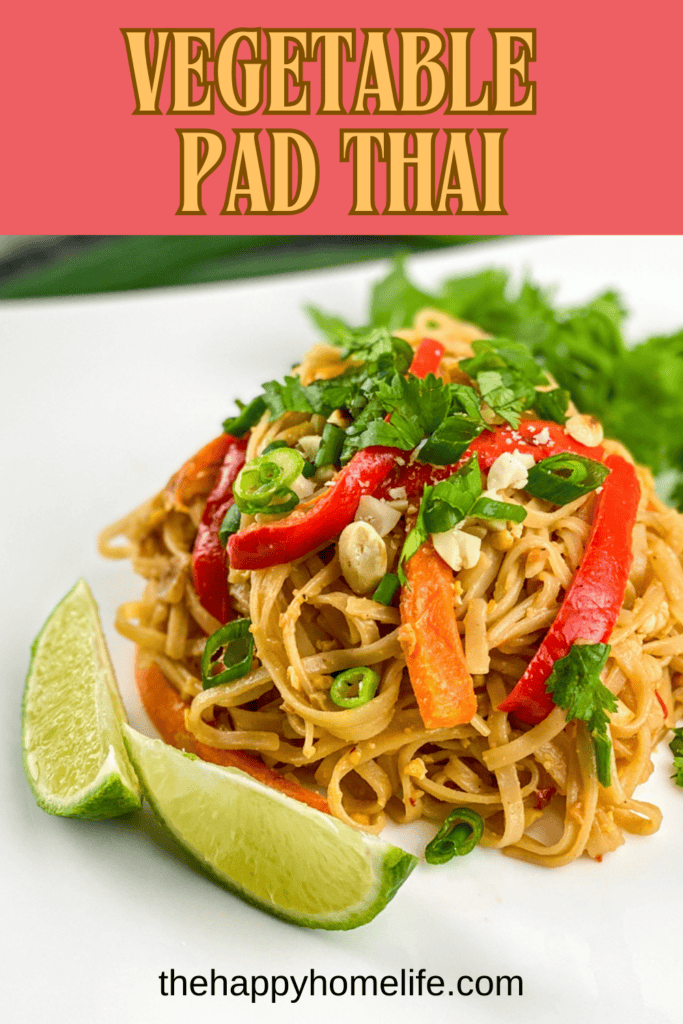
Explore the vibrant flavors of Vegetable Pad Thai, where the tangy sweetness of tamarind sauce melds perfectly with crisp vegetables and tender noodles. It’s a dish that balances nutrition with taste, offering a delightful experience for any mealtime.
Give it a try, and don’t forget to share your feedback and spread the joy of this recipe with friends and family!
Vegetable Pad Thai
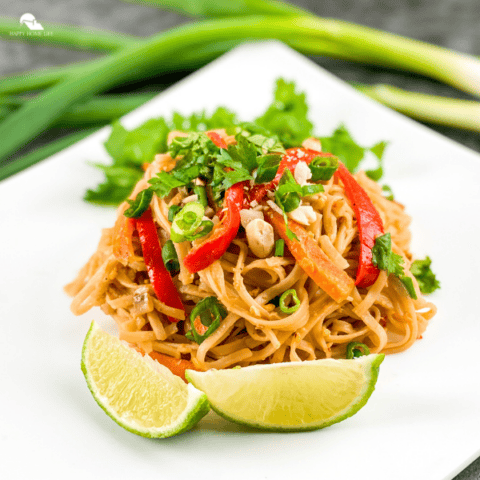
This recipe was tested with both white and brown rice noodles. They work equally well and require the same amount of time to prepare. Ultimately, the choice comes down to your personal preference.
However, the brown variety offers more fiber and protein per serving. This may vary from one brand to another, however, so be sure to check the brand you are using if this is important to you.
Ingredients
Pad Thai Ingredients:
- 8 oz. box rice noodles
- 1 T. sesame oil
- ½ medium shallot, finely chopped
- 3 large green onions, sliced, white and green parts separated
- 1 medium carrot, cut into matchsticks (as shown)
- 1 medium red pepper, sliced
- 2 large eggs, whisked
- ½ c. roasted peanuts, chopped and divided
- 3 T. cilantro leaves, chopped
- 2 large limes, cut into wedges
- Optional: Crushed red pepper flakes, to serve
Sauce Ingredients:
- 1/3 c. honey
- 3 T. fish sauce
- 2 T. tamari or coconut aminos
- 1 T. rice vinegar
- 2 T. fresh lime juice
- 2 T. sugar-free creamy peanut butter
- 1 T. garlic chili sauce (add link)
Instructions
- Prepare rice noodles according to package instructions. Rinse under cool water and set aside.
- While waiting for the water to boil for the rice noodles, add the sauce ingredients to a small skillet set over medium-low heat. Stir continually until the peanut butter is melted and the sauce is heated through, approximately 3-4 minutes. Remove from heat and set aside.
- Add the sesame oil to a large non-stick skillet set over medium heat. Add the shallot, white part of the green onions, carrots, and red pepper. Cook, stirring frequently, until the vegetables are crisp tender and develop some color, approximately 4-5 minutes.
- Push the vegetables to one side of the skillet with a spatula. Add the whisked eggs to the other side. Cook, stirring and chopping frequently with the spatula, until the eggs are cooked through and broken into very small pieces, approximately 4-5 minutes.
- Add the prepared rice noodles, one-third cup chopped peanuts, and the warm sauce to the skillet and stir to combine.
- Transfer to individual serving dishes and top with the remaining roasted peanuts, green onion tops, and fresh cilantro. Serve immediately with lime wedges and crushed red pepper flakes, if desired, on the side. Enjoy!
Notes
Although they aren’t used here, bean sprouts are commonly found in many Pad Thai recipes.
Nutrition Information:
Yield:
4Serving Size:
1Amount Per Serving: Calories: 440Total Fat: 19gSaturated Fat: 3gTrans Fat: 0gUnsaturated Fat: 13gCholesterol: 93mgSodium: 1828mgCarbohydrates: 60gFiber: 5gSugar: 35gProtein: 13g
These nutritional calculations might not be accurate. Please speak with a licensed nutritionist to assist you.

